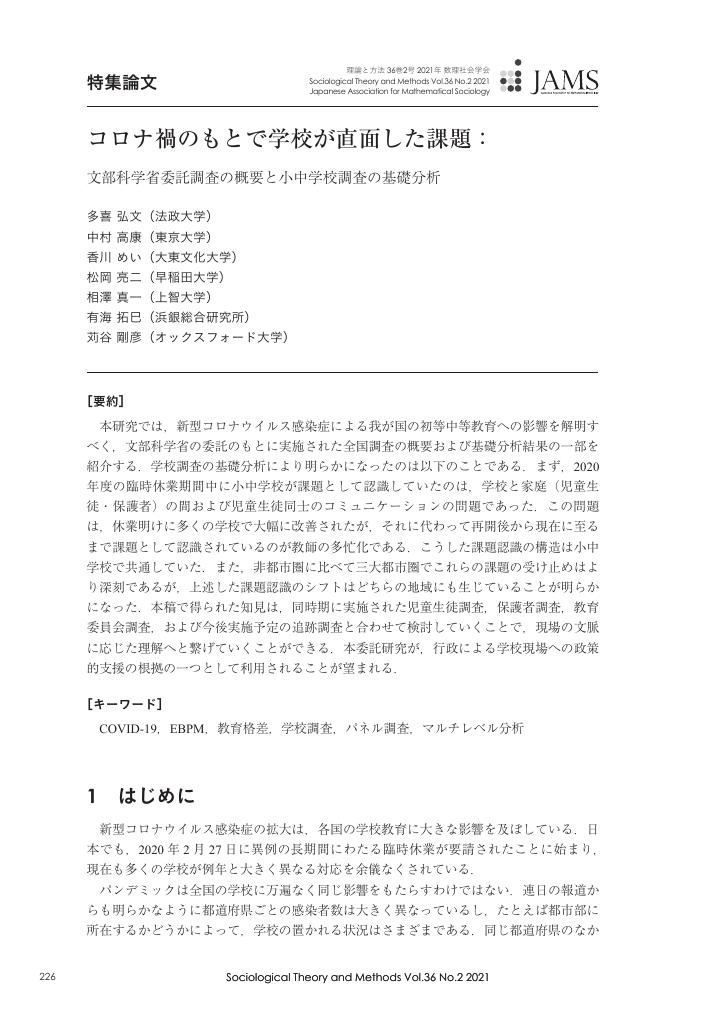12 0 0 0 OA コロナ禍のもとで学校が直面した課題: 文部科学省委託調査の概要と小中学校調査の基礎分析
10 0 0 0 OA 戦後日本における高卒学歴の意味の変遷
- 著者
- 香川 めい 相澤 真一
- 出版者
- 日本教育社会学会
- 雑誌
- 教育社会学研究 (ISSN:03873145)
- 巻号頁・発行日
- vol.78, pp.279-301, 2006-05-31 (Released:2011-03-18)
- 参考文献数
- 22
- 被引用文献数
- 2 1
The aim of this paper is to investigate when and how the meaning of high school diplomas changed during the era of educational expansion in two senses:(1) ubjective and (2) objective. More concretely, it examines:(1) how people recognized high school diplomas and (2) how high school diplomas functioned in the achievement of occupational and economic status. To examine these points, the authors focus on postwar Japan, when the high school enrollment rate rose dramatically under the new educational system. The data used in the analyses are Social Stratification and Social Mobility (SSM) data collected every ten years since 1955.Three cohorts, divided according to the high school enrollment rate, are compared. The high school enrollment rate is 50% to 65% among the first cohort, 66% to 89% for the second, and more than 90% for the third. The enrollment rate increased continuously during the first and second cohorts, so the former is named the “early phase” and the latter the “later phase.” The enrollment rate reaches a plateau in the third. “Desired educational level” and “desired occupation” are used in the analysis of subjective meaning. “Occupation of first job, ” “occupation of present job, ” and “present personal income” are used to clarify the meaning in an objective sense.The analysis of subjective meaning reveals the following. As the high schoolenrollment rate increased dramatically, the desired level of education rose with it. More people wanted to go on to higher level of education: high school and higher education. But the desired occupation of people who wanted to go to high school was almost the same for the early phase and later phase cohorts. However, the actual first jobs of high school graduates in the two cohorts were very different. Fewer people obtained white-collar jobs and more entered into blue-collar jobs in the latter cohort.Comparing present job and present personal income for each of the four data sets since 1965, the three cohorts can be characterized as follows. In the early phase, a relatively large number of people acquired white-collar jobs at an early stage of their occupational careers, and a substantive ratio maintained these jobs to 1995. In addition, personal income increased steadily as people of this cohort became older. On the other hand, a large number of people in the later phase cohort started working in blue-collar jobs. But as they got older, they seemed to move into different types of jobs. The personal income of this cohort increased dramatically in 1995. Therefore, it can be said that this cohort “caught up.” For the last cohort, however, there seemed to be little chance of upward mobility in either occupational or economic status.In sum, if only the function of high school diplomas is considered, the meaning of high school diplomas changed between the early and later phase. But if the “catching-up” of members of the later phase and the subjective meaning of high school diplomas is taken into account, there is little difference in how people recognize and value high school diplomas between first two cohorts. Therefore, a distinctive line can be drawn between the later phase and the next cohort (i. e., the plateau), when the premium of being a high school graduate diminished.
6 0 0 0 OA 人文社会科学系大学教育の内容・方法とその職業的レリバンスに関するパネル調査研究
- 著者
- 本田 由紀 濱中 義隆 中村 高康 小山 治 上西 充子 二宮 祐 香川 めい 小澤 昌之 堤 孝晃 河野 志穂 豊永 耕平 河原 秀行 西舘 洋介
- 出版者
- 東京大学
- 雑誌
- 基盤研究(B)
- 巻号頁・発行日
- 2012-04-01
本研究は、人文社会科学系大学教育の分野別の職業的レリバンスを把握することを目的とし、①大学3年時点から卒業後2年目までのパネル調査、②25~34歳の社会人を対象とする質問紙調査、③大学生・卒業生・大学教員を対象とするインタビュー調査を実施した。その結果、主に以下の知見が得られた。(1)人文社会科学系の大学教育の内容・方法には分野別に違いが大きく、教育の双方向性・職業との関連性の双方について教育学・社会学は相対的に水準が高いが、経済学・法学等の社会科学は前者の、哲学・歴史学等の人文科学は後者の、それぞれ水準が相対的に低い。(2)大学教育の内容・方法は卒業後の職業スキルに影響を及ぼしている。
2 0 0 0 OA 若年期における無業への/無業からの移行と高学歴化:21 世紀成年者縦断調査を用いて
2 0 0 0 OA 生徒減少期の高校教育機会
- 著者
- 香川 めい 劉 語霏
- 出版者
- 日本教育社会学会
- 雑誌
- 教育社会学研究 (ISSN:03873145)
- 巻号頁・発行日
- vol.99, pp.5-25, 2016-11-30 (Released:2018-03-26)
- 参考文献数
- 33
- 被引用文献数
- 1
生徒減少期の高校教育機会の確保には,量的不足への対応が求められた拡大期とは異なる位相の問題が孕まれている。この局面では準義務教育機関となった高校に求められる質的に多様なニーズを満たしつつも規模を縮小させることが必要となるからである。本研究は,同じく生徒数の減少に直面しつつある日本,台湾を事例として取り上げ,高校教育機会を維持し続けること,そこで浮かび上がってくる課題について公私関係を軸に検討する。 日台ともに公立高校の供給不足を私立高校が補完して高校拡大が達成されたため,私立高校はセミ・パブリックな性質を持つようになった。加えて,日本では都道府県に公私協議会を設置して入学定員の按分が行われてきた。それは量的変動のショックを負担し合うことで教育機会の安定的な供給に寄与した。しかし,生徒数が減少し続ける中,定員の按分方式では私立高校の経営が維持できなくなる事態が生じつつある。一方,台湾では2014年の「十二年国民基本教育」実施に伴い,義務教育が実質的に高校まで延長された。この政策は教育機会の平準化や質の均質化を目指すものであるが,少子化の進行,地域間格差などの現実に即したものではない。特に地方で私立職業高校の存続を難しくし,政策の意図とは裏腹に教育機会の平等が担保されない事態が生まれつつある。両社会とも縮小局面で,私立高校の役割をふまえ機会の平等をどう保障していくかが問われている。
本研究では、現代日本における文化と不平等の関係を、「文化がもたらす不平等」と「文化へのアクセスの不平等」という観点から、理論的かつ経験的に社会学の観点から分析する。すなわち、①文化が原因となる不平等とは何か、②文化資源の不平等な配分とは何か、という2種類の問題を扱う。これらの問題を研究するために、理論的には社会分化論として文化資本概念を展開させる。社会調査としては、関東地方で郵送調査とインタビュー調査を実施し、調査で収集されるデータを、多重対応分析の特性を活かした混合研究法によって分析する。
1 0 0 0 高校教育研究の展開:―学校格差構造から多様なリアリティへ―
1 0 0 0 OA 後期中等教育拡大期の高卒就職者の世代内移動
- 著者
- 相澤 真一 香川 めい
- 出版者
- The Kantoh Sociological Society
- 雑誌
- 年報社会学論集 (ISSN:09194363)
- 巻号頁・発行日
- vol.2008, no.21, pp.131-142, 2008-07-20 (Released:2012-02-29)
- 参考文献数
- 24
The aim of this paper is to unravel the change in the functions of the high school diploma using time-series variation in the structures of intra-generational mobility.First, we try to set demarcation lines between birth years by examining intra-generational mobility, occupational structure based on the first job, and enrollment ratios in the institutions of higher education. Exploring these three aspects for every birth year between 1932 and 1965, five different phases are inductively suggested. Second, the five different phases are compared with 10-year demarcations to verify the former by analyzing chances for advancement to managerial level. We find that using 10-year phases only shows static and limited results. But result using time divisions developed in the exploratory phase produced results that clearly shown the changing impact of academic attainment depending on the period.
- 著者
- 香川 めい 劉 語霏
- 出版者
- 日本教育社会学会
- 雑誌
- 日本教育社会学会大会発表要旨集録
- 巻号頁・発行日
- no.67, pp.246-249, 2015-09-06


